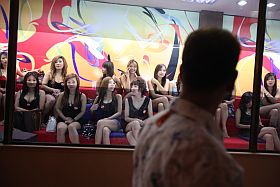The DocsBarcelona Pitching Forum included a Greek film project, presented by Valerie Kontakos and Despina Pavlaki. The Greek women had earlier communicated their experience with a Kickstarter campaign on FB. I had read it and asked if it could go on filmkommentaren.dk as well. No problem was the answer by the two, who had raised $46.117 for their 52/80 minutes documentary-to-be, which has the following logline:
“A documentary about the fiercest girl gang in Greek Orthodox Church history.”
“And this is the synopsis: It all started in 1962, when four best girlfriends decided to run away from home and join a convent. They were dragged back home and unceremoniously locked in their bedrooms, but there was no stopping them now! They escaped a total of three times and were forced to live in hiding for a total of three years. Their parents recruited the police and even had the church forbid the girls to walk through monastery doors. They didn’t just want to become nuns. They wanted to raise other people’s children, which was the next best thing to becoming single mothers. And this was the only way they could make their dreams come true without society getting in the way.”
And the generous advice on the kickstarter experience comes here with a beginning text to be continued via the link to the website that you should read if you intend to do a campaign:
We’re now officially the first Greek feature-length documentary to crowdfund a significant portion of its budget and we couldn’t be happier!!! We want to thank everyone who donated, liked our FB Page, commented on our posts, answered our Tweets, read our newsletters, wrote about the project and told their friends and family about our Kickstarter campaign, we honestly wouldn’t have done it without you.
In recognition of all the love you sent our way, we’d like to give something back, by releasing a guide to everything we did right and, most importantly,
everything we did wrong on Kickstarter, so you guys can do better! Feel free to contact us with questions or comments, we’re happy to help out fellow filmmakers any way we can.
Assemble a Team: Like an actual team of people who will actually work on a daily basis. If you can’t afford a paid staff, hire skilled interns or commit to paying staffers once funding is in place. You’ll need a gifted writer for newsletters, FB posts and blog updates, a popular FB/Twitter user who can send online traffic your way (crucial!), someone with organizational skills and tough skin and someone with flawless English to proof posts, translate newsletters and correct correspondence, especially if your campaign addresses a more international audience. If your “gifted writer” also happens to be a journalist, all the better so he/she can rustle up some positive press for you my calling in some favors! If you’ve already started shooting, you’ll need an editor to prepare some clips you can release over the course of the campaign and a graphic designer to create some art work. A photographer (or serial instagrammer!) for some quirky film stills or behind-the-scenes action would be nice too!
CONTINUE YOUR READING ON:
http://www.exileroom.gr/english-if-only-i-knew-a-mana-guide-to-belated-kickstarter-wisdom/?lang=en
http://www.kickstarter.com/projects/1290581015/mana-a-documentary-about-6-nuns-and-60-children





